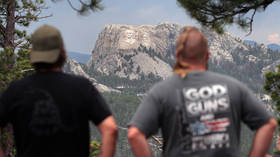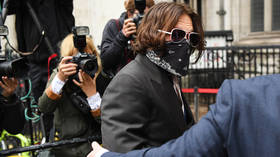Shelter in places apart and unequal: Topple all the monuments you want, but the real racism’s going unaddressed
America pulls down monuments to racist oppressors, renames streets and paints Black Lives Matter all over them. But the real inequalities of cities like Chicago – rooted in class as well as race – are left to fester.
It is good to see Confederate war memorials coming down and under attack in the American South. The Confederacy was a treasonous campaign to keep black people in bondage. It arose and seceded from the United States, leading to a Civil War that killed more than half a million Americans, because top southern slaveholders determined that the presidency of Abraham Lincoln represented a mortal threat to the forced labor and torture system that was black chattel slavery.
But symbolic change only goes so far. America can take down all the racist historical monuments it wants. It can strip slave owners’ and slave traders’ names from every structure they befoul. It can paint “Black Lives Matter” on every major thoroughfare in the nation.
But substance matters more than symbols, just as deeds matter more than words (you know, like “hope” and “change”). The technically black Barack Obama held the White House in the land of cotton slavery for eight years. During his presidency, Black Americans experienced an epic collapse in net worth. “Racially disparate mass incarceration”(a nice academic phrase for the disproportionate mass arrest and imprisonment of black and brown people) and racist police brutality proceeded apace while liberals congratulated themselves for having voted (twice) for a (deeply conservative) first black president (an imperial Wall Street president who lectured poor blacks on their own responsibility for their poverty while bailing out financial institutions that collapsed black wealth along with the US and global economies).
Take my hometown, Chicago, the one-third black city that Obama deceptively claimed to hail from. It recently elected a black, female and gay mayor (a symbolic identity politics trifecta!) and named one its leading downtown streets after the 20th century black civil rights activist Ida B. Wells. Black people are highly visible on the city’s nightly television news teams, in its sports and entertainment culture and across its entire roster of elected officials.
Good. Has symbolic change challenged the massive concentration of deep Black poverty across vast ghettoized swaths of the city’s South and West Sides? Has it brought new opportunity and uplifted those communities? Has superficially integrated Chicago made any substantive effort to reverse the flows of profit, development, and privilege from the richest and whitest parts of the city and metropolitan area to the poorest and most black parts of the metropolis? Has it switched tax increment financing surpluses and other government subsidies from lining the already deep pockets of downtown developers to creating affordable housing, livable wage jobs, medical resources, and green spaces in the city’s multiply oppressed Black communities? Has it begun to compensate those communities for more than a century of harsh housing and school segregation, restrictive covenants, red-lining, disinvestment, employment discrimination, gentrification, and police-state torture and terrorism?
Has Chicago moved to dismantle the giant racist holding pen and coronavirus breeding ground called Cook County Jail? Has it de-funded its viciously racist and militarized police department, diverting the taxpayer fortune it spends on repression to social protection and enrichment in the city’s communities of greatest need?
No, it has not. And it’s the same in every other American metropolis.
Americans need to think about “place” in social as well as spatial terms. They also need to understand the longstanding core national problems of race at a deeper, class-informed level beyond just the color of faces in high places and symbols in public spaces.
Also on rt.com Trump says Democrats 'hate America.' Their attacks on Mt. Rushmore seem designed to prove him rightThey could start by reflecting on how differently the phrase “shelter in place” plays out across the nation’s interwoven boundaries of race and class.
Think about the spaces where disproportionately middle- and upper-class people have “sheltered in place” in Chicago this year. Comfortable city residents have been harboring in the vast, predominantly white affluent stretches of the city’s North Side along with other cozy semi-integrated pockets in South Side neighborhoods like Hyde Park and Beverly. Residents of these pleasing neighborhoods work from often spacious, nicely furnished, and well-stocked homes, in good-paying jobs that come with gold-plated health insurance plans. They have high-end coffee shops, health carry-outs, doctors’ and dentist offices, full-service grocery stores with organic food, and well-kept city parks and more nearby. (Some of these neighborhoods’ residents will almost sheepishly tell you that Covid-19 has been a delightful opportunity to work in the comfort of their homes without commutes, business suits, and direct oversight from senior authorities).
Things are different in the shockingly impoverished and jobless ghettoes on Chicago’s South and West Sides. There, black Americans shelter in savagely separate and unequal places. Grocery stores, banks, professional services, and green space are shockingly scarce in black Chicago. So are job networks and decent, well-funded schools. Sidewalks and parking lots in these neighborhoods are strewn with broken glass alongside boarded-up storefronts and ubiquitous liquor stores. Air conditioning is a luxury and social distancing is difficult in overcrowded, rent-racked apartments with shelves that are often all-too-bare. Heavily armed police patrol warily and menacingly.
Life expectancy, already low, is plummeting in these neighborhoods as residents struggle with numerous pre-existing “co-morbidities” – including the lack of health insurance and a scarcity of medical services – that make Covid-19 especially dangerous. To make matters worse, Black Chicagoans have been especially exposed to the virus thanks to their disproportionate presence in front-line service jobs. “Working from home,” noted the journalist Carlos Ballesteros last April in the Chicago Sun Times, “is not an option for most Black and Latino workers during the coronavirus crisis.”
None of this is unique to Chicago. America is telling tens of millions of black Americans to shelter in savagely unequal place as the uncompensated and living, compound-interest legacies of slavery, Jim Crow, ghettoization, and more steal and maim black lives on an elevated scale in the coronavirus era.
Is it any wonder that many urban black Americans exploded in rage after George Floyd was killed by white police officers in Minneapolis? And that some Black Americans came out of their assigned places to attack property and appropriate goods not just in their own assigned communities but in downtown commercial centers like Chicago’s Loop and Midtown Manhattan? Or that urban black America could be looking at a long, hot violence-prone summer as misery mounts in the nation’s worst-off places?
More statues will come down, more “Black Lives Matter” signs will go up, more street names will change. Fine. What’s really required is a massive redirection of wealth and resources understood as reparations not just for past racial oppression but for ongoing systemic and institutional racism, deeply understood – and a related frontal assault on the soulless class-rule profits system that has always underpinned American racism.
“The real issue to be faced” beyond surface matters like the technical skin color of an elected official, the socialist Dr Martin Luther King, Jr. wrote near the end of his life, “is the radical reconstruction of society itself.” There’s a word for that kind of reparation: revolution.
Think your friends would be interested? Share this story!
The statements, views and opinions expressed in this column are solely those of the author and do not necessarily represent those of RT.















